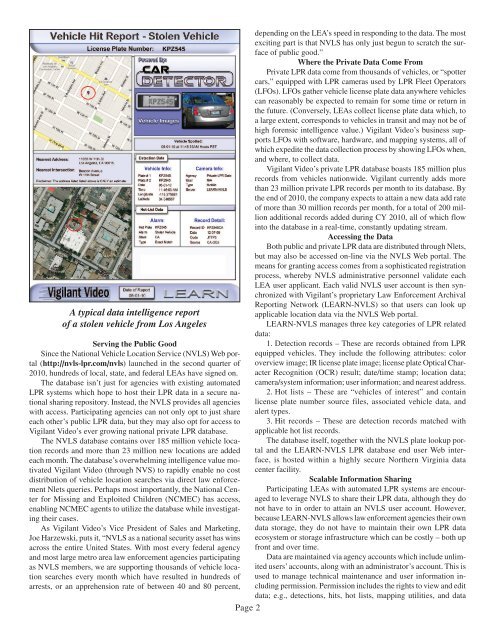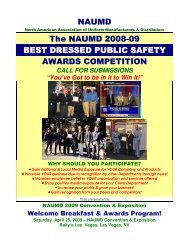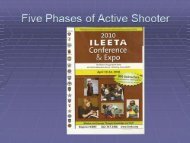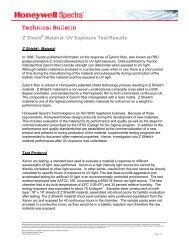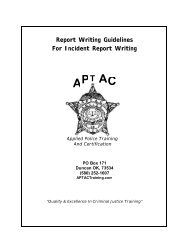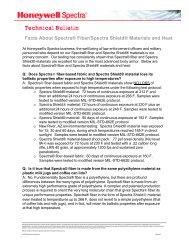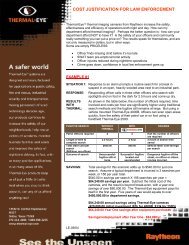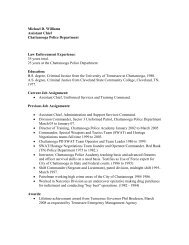The National Vehicle Location Service
The National Vehicle Location Service
The National Vehicle Location Service
Create successful ePaper yourself
Turn your PDF publications into a flip-book with our unique Google optimized e-Paper software.
A typical data intelligence report<br />
of a stolen vehicle from Los Angeles<br />
Serving the Public Good<br />
Since the <strong>National</strong> <strong>Vehicle</strong> <strong>Location</strong> <strong>Service</strong> (NVLS) Web portal<br />
(http://nvls-lpr.com/nvls) launched in the second quarter of<br />
2010, hundreds of local, state, and federal LEAs have signed on.<br />
<strong>The</strong> database isn’t just for agencies with existing automated<br />
LPR systems which hope to host their LPR data in a secure national<br />
sharing repository. Instead, the NVLS provides all agencies<br />
with access. Participating agencies can not only opt to just share<br />
each other’s public LPR data, but they may also opt for access to<br />
Vigilant Video’s ever growing national private LPR database.<br />
<strong>The</strong> NVLS database contains over 185 million vehicle location<br />
records and more than 23 million new locations are added<br />
each month. <strong>The</strong> database’s overwhelming intelligence value motivated<br />
Vigilant Video (through NVS) to rapidly enable no cost<br />
distribution of vehicle location searches via direct law enforcement<br />
Nlets queries. Perhaps most importantly, the <strong>National</strong> Center<br />
for Missing and Exploited Children (NCMEC) has access,<br />
enabling NCMEC agents to utilize the database while investigating<br />
their cases.<br />
As Vigilant Video’s Vice President of Sales and Marketing,<br />
Joe Harzewski, puts it, “NVLS as a national security asset has wins<br />
across the entire United States. With most every federal agency<br />
and most large metro area law enforcement agencies participating<br />
as NVLS members, we are supporting thousands of vehicle location<br />
searches every month which have resulted in hundreds of<br />
arrests, or an apprehension rate of between 40 and 80 percent,<br />
Page 2<br />
depending on the LEA’s speed in responding to the data. <strong>The</strong> most<br />
exciting part is that NVLS has only just begun to scratch the surface<br />
of public good.”<br />
Where the Private Data Come From<br />
Private LPR data come from thousands of vehicles, or “spotter<br />
cars,” equipped with LPR cameras used by LPR Fleet Operators<br />
(LFOs). LFOs gather vehicle license plate data anywhere vehicles<br />
can reasonably be expected to remain for some time or return in<br />
the future. (Conversely, LEAs collect license plate data which, to<br />
a large extent, corresponds to vehicles in transit and may not be of<br />
high forensic intelligence value.) Vigilant Video’s business supports<br />
LFOs with software, hardware, and mapping systems, all of<br />
which expedite the data collection process by showing LFOs when,<br />
and where, to collect data.<br />
Vigilant Video’s private LPR database boasts 185 million plus<br />
records from vehicles nationwide. Vigilant currently adds more<br />
than 23 million private LPR records per month to its database. By<br />
the end of 2010, the company expects to attain a new data add rate<br />
of more than 30 million records per month, for a total of 200 million<br />
additional records added during CY 2010, all of which flow<br />
into the database in a real-time, constantly updating stream.<br />
Accessing the Data<br />
Both public and private LPR data are distributed through Nlets,<br />
but may also be accessed on-line via the NVLS Web portal. <strong>The</strong><br />
means for granting access comes from a sophisticated registration<br />
process, whereby NVLS administrative personnel validate each<br />
LEA user applicant. Each valid NVLS user account is then synchronized<br />
with Vigilant’s proprietary Law Enforcement Archival<br />
Reporting Network (LEARN-NVLS) so that users can look up<br />
applicable location data via the NVLS Web portal.<br />
LEARN-NVLS manages three key categories of LPR related<br />
data:<br />
1. Detection records – <strong>The</strong>se are records obtained from LPR<br />
equipped vehicles. <strong>The</strong>y include the following attributes: color<br />
overview image; IR license plate image; license plate Optical Character<br />
Recognition (OCR) result; date/time stamp; location data;<br />
camera/system information; user information; and nearest address.<br />
2. Hot lists – <strong>The</strong>se are “vehicles of interest” and contain<br />
license plate number source files, associated vehicle data, and<br />
alert types.<br />
3. Hit records – <strong>The</strong>se are detection records matched with<br />
applicable hot list records.<br />
<strong>The</strong> database itself, together with the NVLS plate lookup portal<br />
and the LEARN-NVLS LPR database end user Web interface,<br />
is hosted within a highly secure Northern Virginia data<br />
center facility.<br />
Scalable Information Sharing<br />
Participating LEAs with automated LPR systems are encouraged<br />
to leverage NVLS to share their LPR data, although they do<br />
not have to in order to attain an NVLS user account. However,<br />
because LEARN-NVLS allows law enforcement agencies their own<br />
data storage, they do not have to maintain their own LPR data<br />
ecosystem or storage infrastructure which can be costly – both up<br />
front and over time.<br />
Data are maintained via agency accounts which include unlimited<br />
users’ accounts, along with an administrator’s account. This is<br />
used to manage technical maintenance and user information including<br />
permission. Permission includes the rights to view and edit<br />
data; e.g., detections, hits, hot lists, mapping utilities, and data


